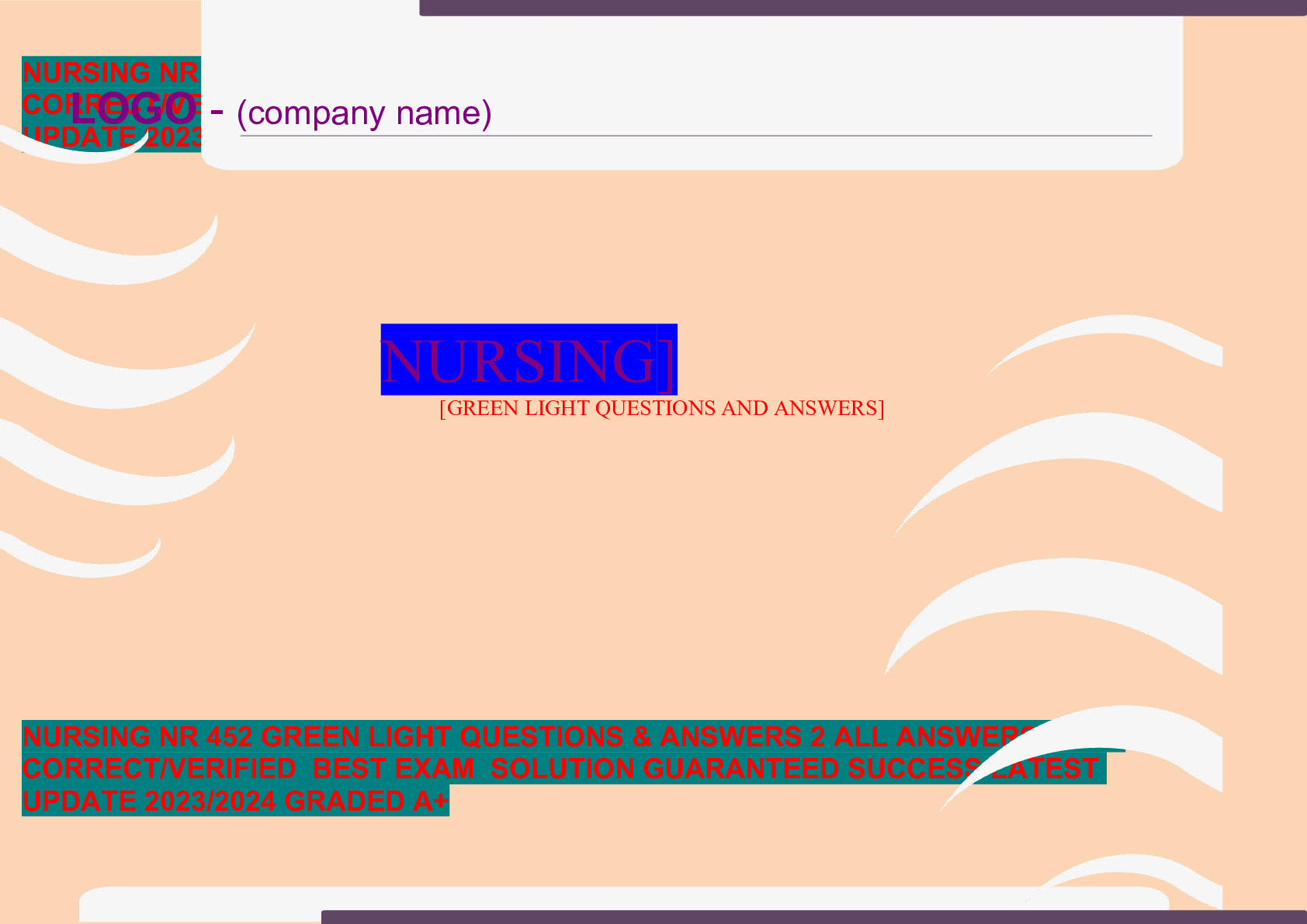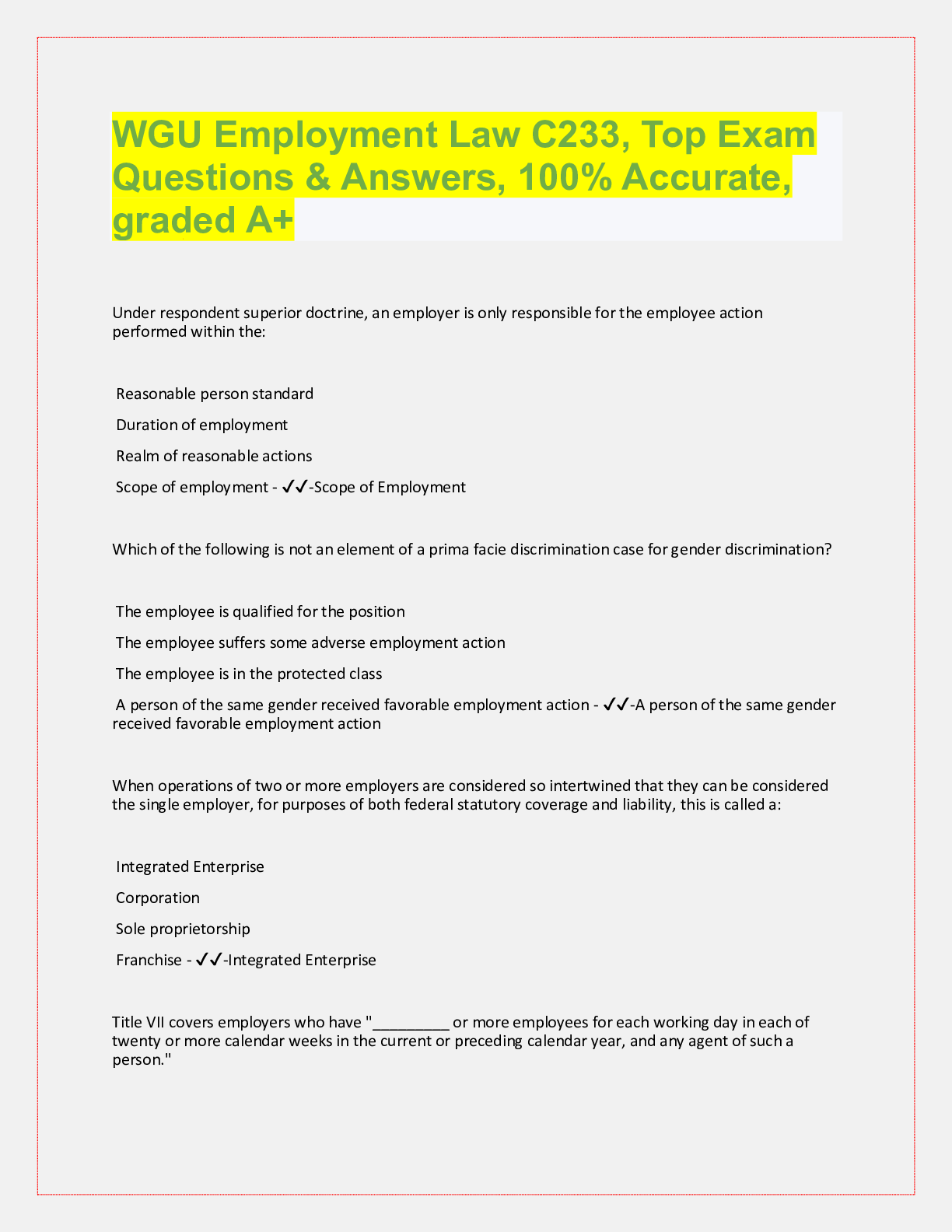*NURSING > QUESTIONS & ANSWERS > NR 222 Unit 6 Test Bank Chapter 12; Conception Through Adolescence, Latest 2020 complete Questions & (All)
NR 222 Unit 6 Test Bank Chapter 12; Conception Through Adolescence, Latest 2020 complete Questions & Answers (verified all correct).
Document Content and Description Below
NR 222 Unit 6 Test Bank Chapter 12; Conception Through Adolescence Chapter 12: Conception Through Adolescence, pp. 141–158) Potter et al.: Fundamentals of Nursing, 9th Edition MULTIPLE CHOICE 1.... A mother has delivered a healthy newborn. Which action is priority? a. Encourage close physical contact as soon as possible after birth. b. Isolate the newborn in the nursery during the first hour after delivery. c. Never leave the newborn alone with the mother during the first 8 hours after delivery. d. Do not allow the newborn to remain with parents until the second hour after delivery. 2. A nurse teaches a new mother about the associated health risks to the infant. Which statement by the mother indicates a correct understanding of the teaching? a. “I will feed my baby every 4 hours around-the-clock.” b. “I need to leave the blankets off my baby to prevent smothering.” c. “I need to remind friends who want to hold my baby to wash their hands.” d. “I will throw away the bulb syringe now because my baby is breathing fine.” 3. A nurse is working in the delivery room. Which action is priority immediately after birth? a. Open the airway. b. Determine gestational age. c. Monitor infant-parent interactions. d. Promote parent-newborn physical contact. 4. A nurse is assessing a newborn that was just born. Which newborn finding will cause the nurse to intervene immediately? a. Molding b. A lack of reflexes c. Cyanotic hands and feet d. A soft, protuberant abdomen 5. A nurse performs an assessment on a healthy newborn. Which assessment finding will the nurse document as normal? a. Cyanosis of the feet and hands for the first 48 hours b. Triangle-shaped anterior fontanel c. Sporadic motor movements d. Weight of 4800 grams 6. A nurse is teaching the staff about development. Which information indicates the nurse needs to follow up? a. “Development proceeds in a cephalocaudal pattern.” b. “Development proceeds in a proximal-distal pattern.” c. “Development proceeds at a slower rate during the embryonic stage.” d. “Development proceeds at a predictive rate from the moment of conception.” 7. A nurse is comparing physical growth patterns between school-aged children and adolescents. Which principle should the nurse consider? a. Physical growth usually slows during the adolescent period. b. Secondary sex characteristics usually develop during the adolescent years. c. Boys usually exceed girls in height and weight by the end of the school years. d. The distribution of muscle and fat remains constant during the adolescent years. 8. The parent brings a child to the clinic for a 12-month well visit. The child weighed 6 pounds 2 ounces and was 21 inches long at birth. Which finding will cause the nurse to intervene? a. Height of 30 inches b. Weight of 16 pounds c. Is not yet potty-trained d. Is not yet walking up stairs 9. A nurse is assessing the cognitive changes in a preschooler. Which standard will the nurse use to determine normal? a. “I will feed my baby every 4 hours around-the-clock.” b. “I need to leave the blankets off my baby to prevent smothering.” c. “I need to remind friends who want to hold my baby to wash their hands.” d. “I will throw away the bulb syringe now because my baby is breathing fine.” 10. The nurse is teaching a parenting class. One of the topics is development. Which statement from a parent indicates more teaching is needed? a. “The toddler may use parallel play.” b. “The preschooler has the ability to play in small groups.” c. “The school-aged child still needs total assistance in all safety activities.” d. “The toddler may have temper tantrums from parent’s acting on safety rules.” 11. The nurse is observing a 2-year-old hospitalized patient in the playroom. Which activity will the nurse most likely observe? a. Seeking out same sex children to play with b. Participating as the leader of a small group activity c. Sitting beside another child while playing with blocks d. Separating building blocks into groups by size and color 12. A nurse is communicating with a newly admitted teenaged patient. Which action should the nurse take? a. Avoid questioning the patient about cigarette use when the nurse observes a cigarette lighter lying on the bedside table. b. Complete the admission database as quickly as possible by asking yes and no questions. c. Look for meaning behind the patient’s words and actions. d. Ignore the patient’s withdrawn behavior. 13. A nurse is caring for a preschooler. Which fear should the nurse most plan to minimize? a. Fear of bodily harm b. Fear of weight gain c. Fear of separation d. Fear of strangers 14. A nurse is teaching a class about the effects of nutrition on fetal growth and development. A pregnant patient asks the nurse how much weight should normally be gained over the pregnancy. Which information should the nurse share with the patient? a. About 10 to 20 pounds b. About 15 to 25 pounds c. About 20 to 30 pounds d. About 25 to 35 pounds 15. The nurse is caring for an infant. Which activity is most appropriate for the nurse to offer to the infant? a. Set of cards to organize and separate into groups b. Set of sock puppets with movable eyes c. Set of plastic stacking rings d. Set of paperback book 16. A mother expresses concern because her 5-year-old child frequently talks about friends who don’t exist. What is the nurse’s best response to this mother’s concern? a. “Have you considered a child psychological evaluation?” b. “You should stop your child from playing electronic games.” c. “Pretend play is a sign your child watches too much television.” d. “It’s very normal for a child this age to have imaginary playmates.” 17. A school nurse is encouraging children to play a game of kickball. Which group of children is the nurse most likely addressing? a. Infant b. Toddler c. Preschool d. School-aged 18. Which assessment finding of a school-aged patient should alert the nurse to a possible developmental delay? a. Verbalization of “I have no friends” b. Absence of secondary sex characteristics c. Curiosity about sexuality d. Lack of group identity 19. The nurse is teaching a parent about developmental needs of a 9-month-old infant. Which statement from the parent indicates a correct understanding of the teaching? a. “My child will begin to speak in sentences by 1 year of age.” b. “My child will probably enjoy playing peek-a-boo.” c. “My child will sleep about 7 to 8 hours a night.” d. “My child will be ready to try low-fat milk.” 20. A nurse is teaching the parents of a school-aged child about accidents most common in this age group. Which topic should the nurse address? a. Falls b. Fires c. Drownings d. Poisonings 21. Which information from the parent of an 8-month-old infant will cause the nurse to intervene? a. My baby rides in the front-facing car seat when I go to the grocery store. b. I made sure the slats on the crib were less than 2 inches apart. c. I removed the mobile after my baby could reach it. d. My baby cries every time he sees a new person. 22. The nurse is preparing to teach a group of parents with infants about growth and development. Which information should the nurse include in the teaching session? a. 3-month-old infants will be able to bang objects together. b. 4-month-old infants will be able to sit alone with support. c. 5-month-old infants will be able to creep on hands and knees. d. 6-month-old infants will be able to turn from back to abdomen. 23. Which statement, if made by a parent, will require further instruction from the nurse? a. “I should not be surprised that my teenage son has so many friends.” b. “I get worried because my teenage son thinks he’s indestructible.” c. “I should cover for my 10-year-old son when he makes mistakes until he learns the ropes.” d. “I usually have nutritious snacks available because my 10-year-old son is always hungry right after school.” 24. A nurse is teaching parents about appropriate activities for different age groups. Which toy, if selected by the parent of a 12-month-old infant, will indicate a correct understanding of the teaching? a. Busy box b. Electronic games c. Game requiring two to four people d. Small, plastic alphabet letters and magnets MULTIPLE RESPONSE 1. A nurse is teaching a parenting class for families with adolescents. Which health concerns will the nurse include in the teaching session? (Select all that apply.) a. Suicide b. Eating disorders c. Violence/Homicide d. Sexually transmitted infections e. Gonadotropic hormone stimulation MATCHING A nurse is teaching parents about the fine motor skills of infants to help parents understand development growth and needs. Match the information to the correct age that the nurse should include in the teaching session. a. Can place objects into containers b. Pulls a string to obtain an object c. Can hold a baby bottle d. Holds rattle for short periods e. Uses pincer grasp well 1. 2 to 4 months 2. 4 to 6 months 3. 6 to 8 months 4. 8 to 10 months 5. 10 to 12 months [Show More]
Last updated: 1 year ago
Preview 1 out of 5 pages
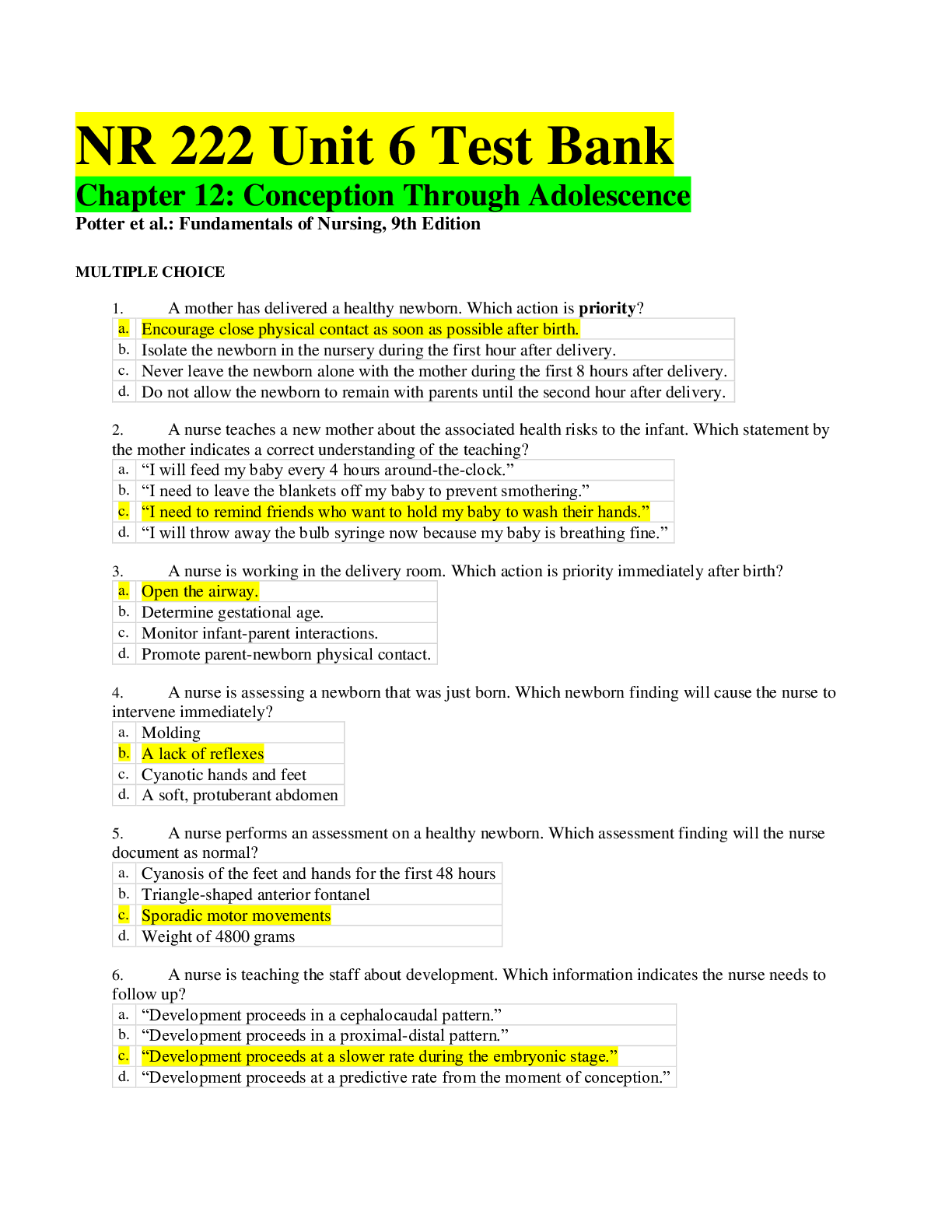
Reviews( 0 )
Document information
Connected school, study & course
About the document
Uploaded On
Apr 03, 2020
Number of pages
5
Written in
Additional information
This document has been written for:
Uploaded
Apr 03, 2020
Downloads
0
Views
50

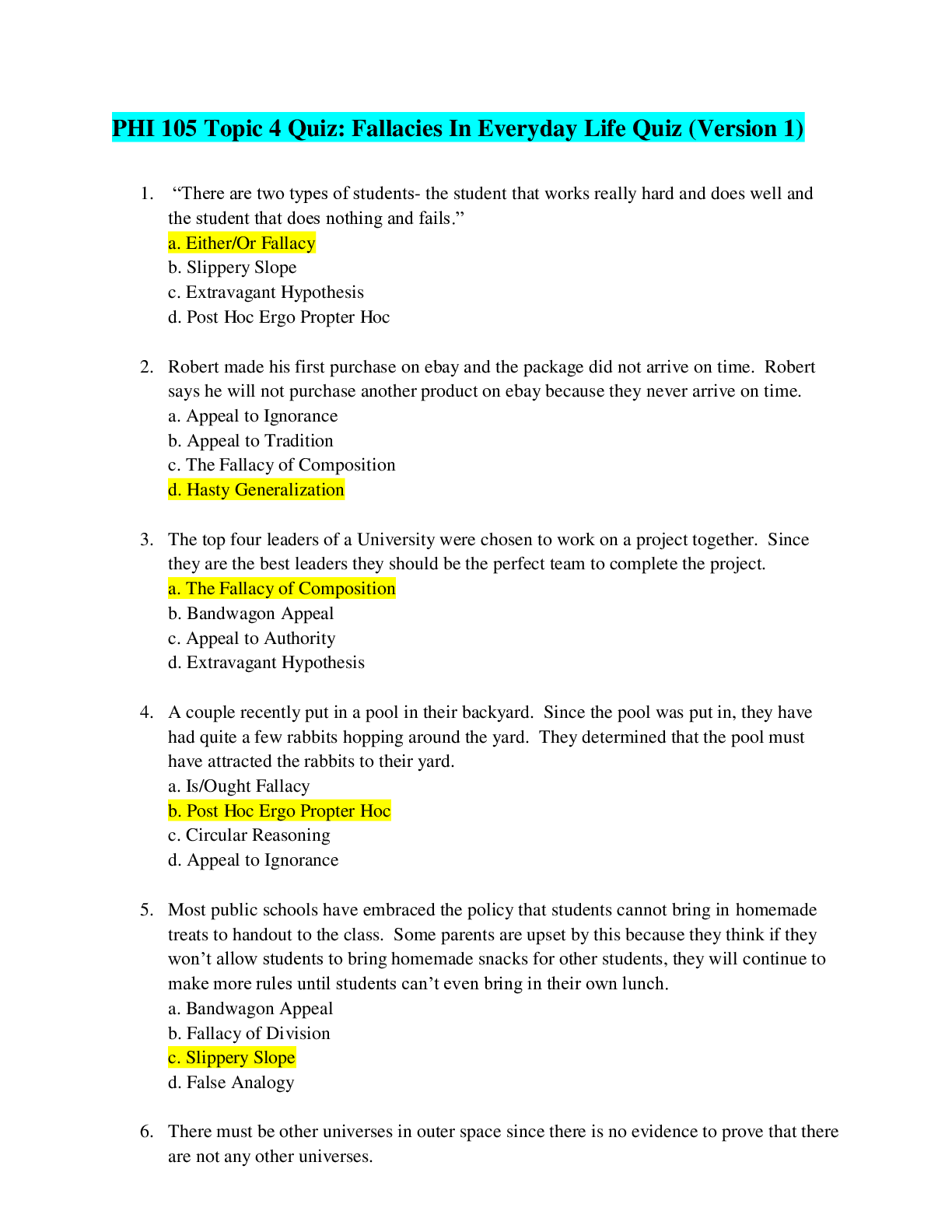


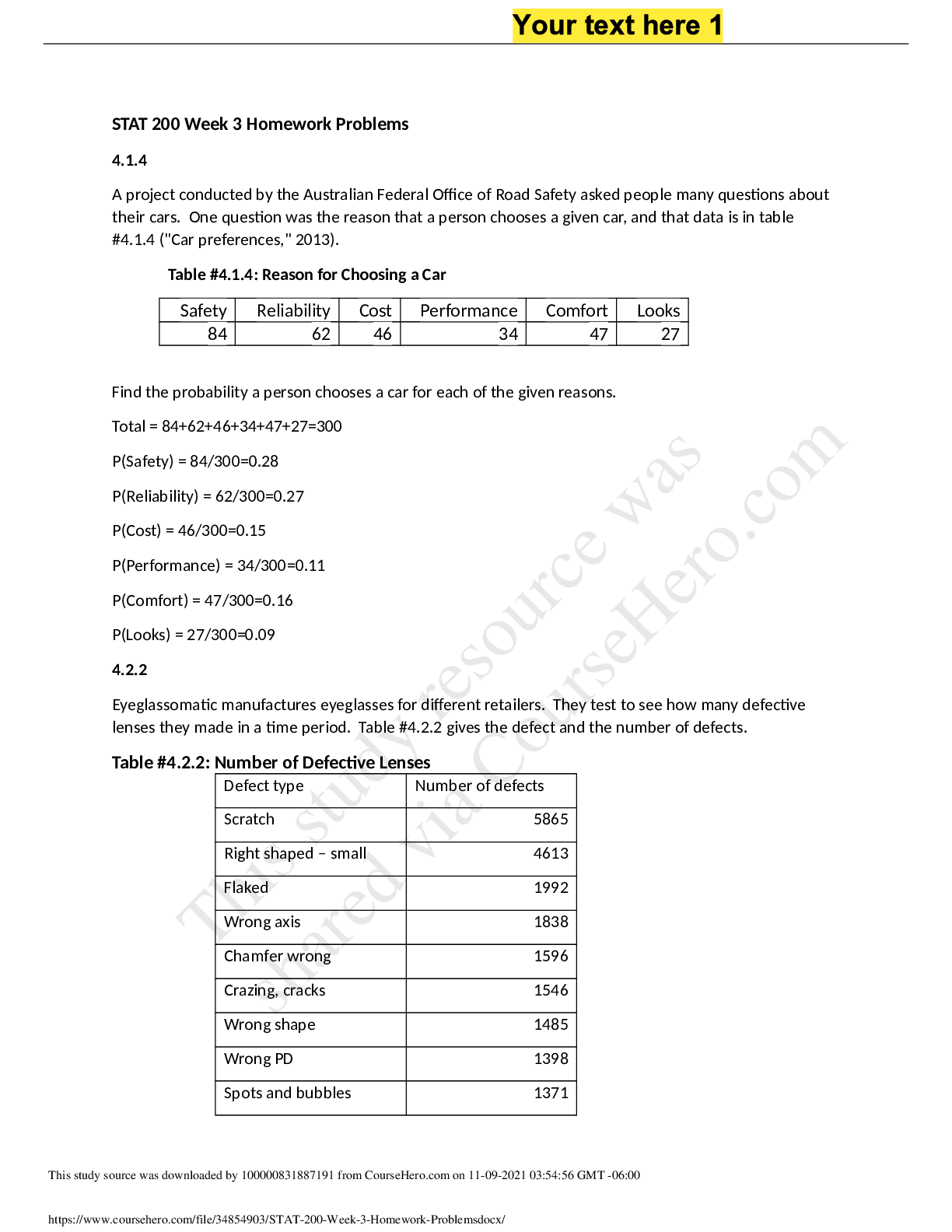
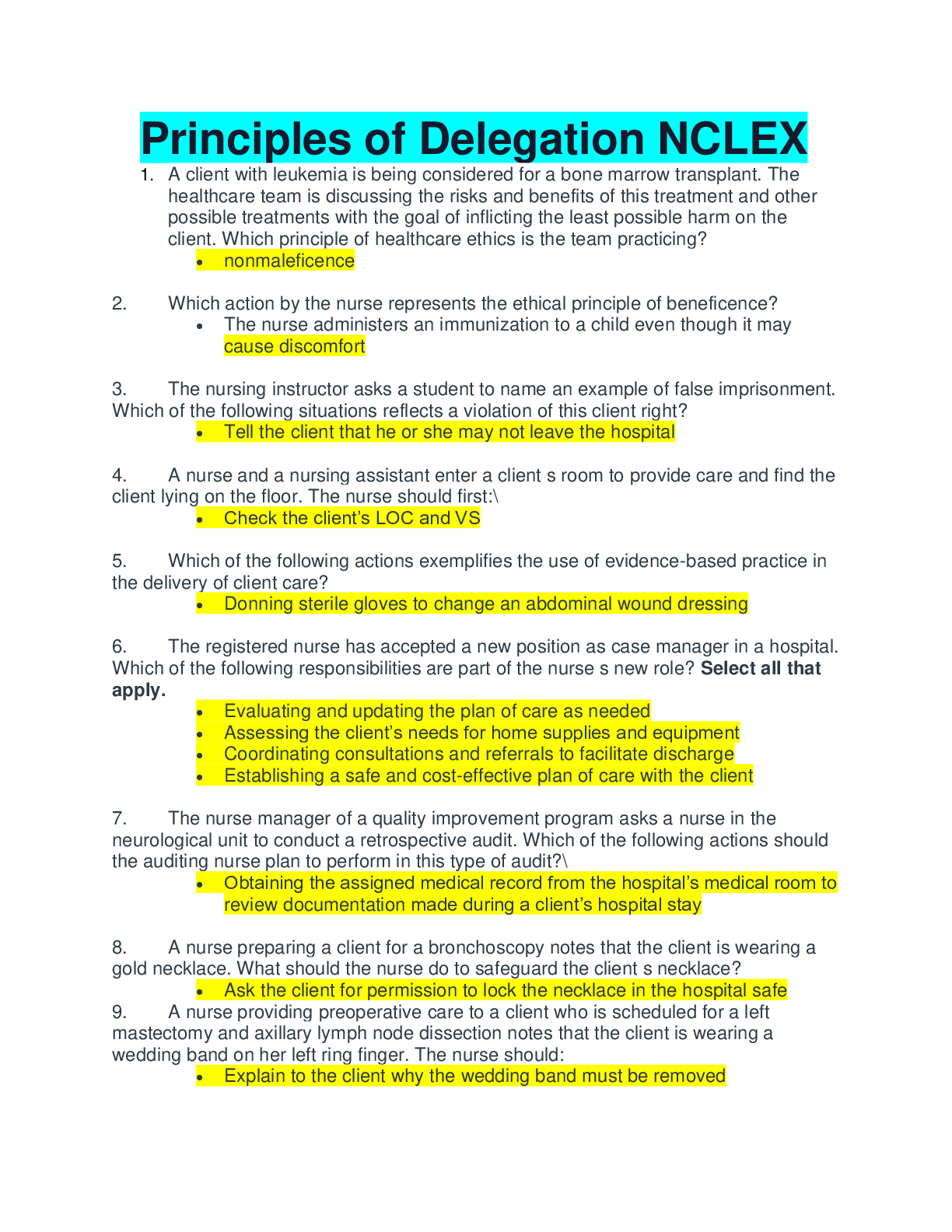
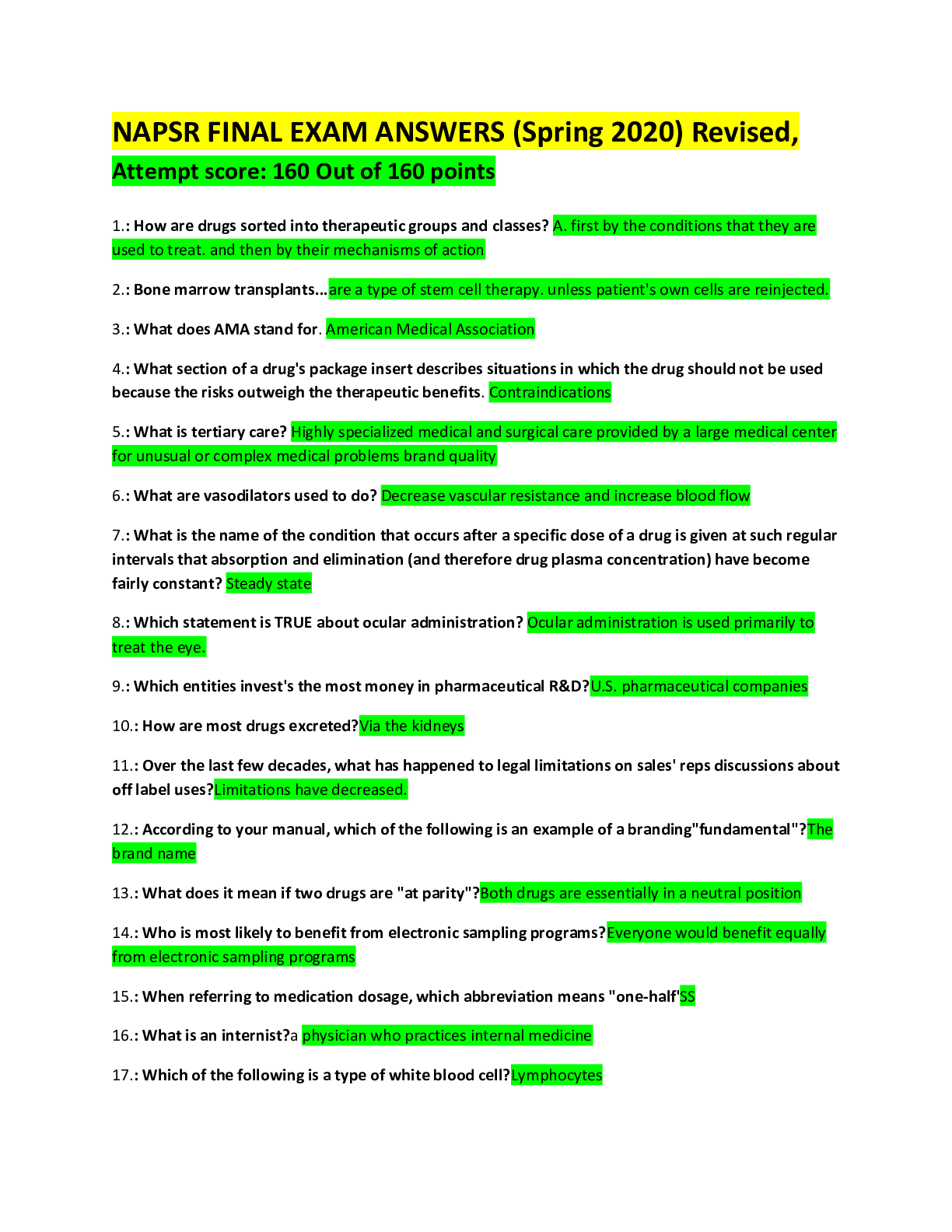
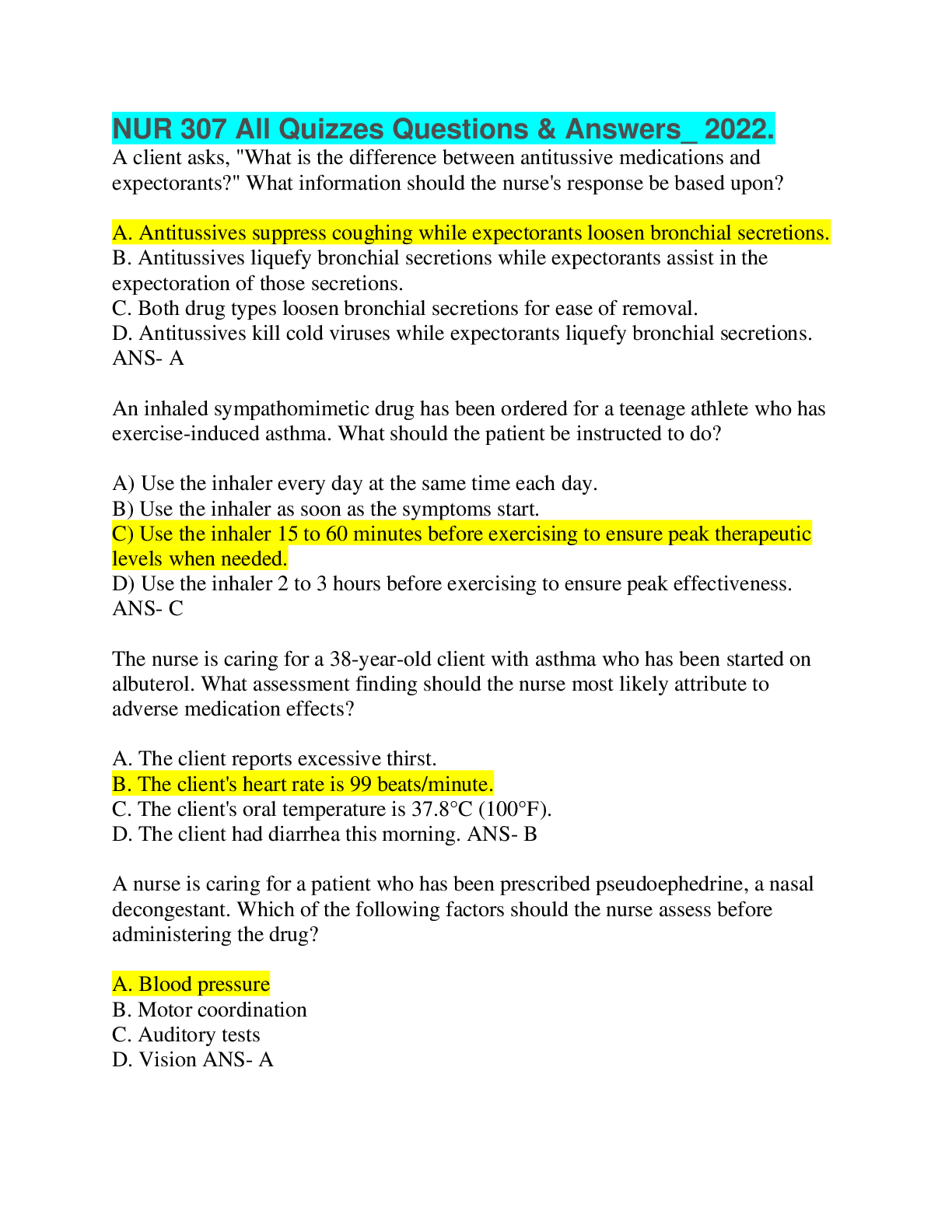
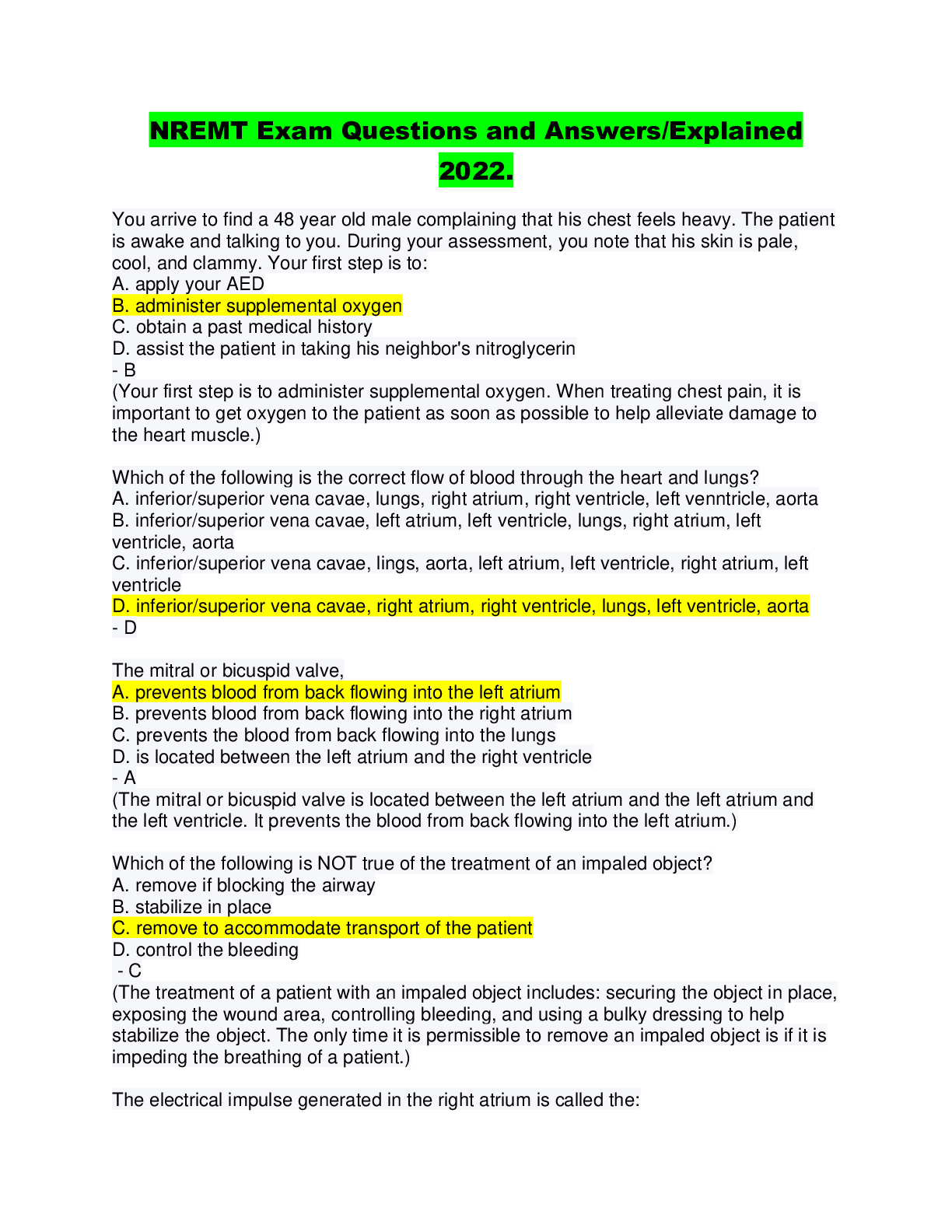

.png)
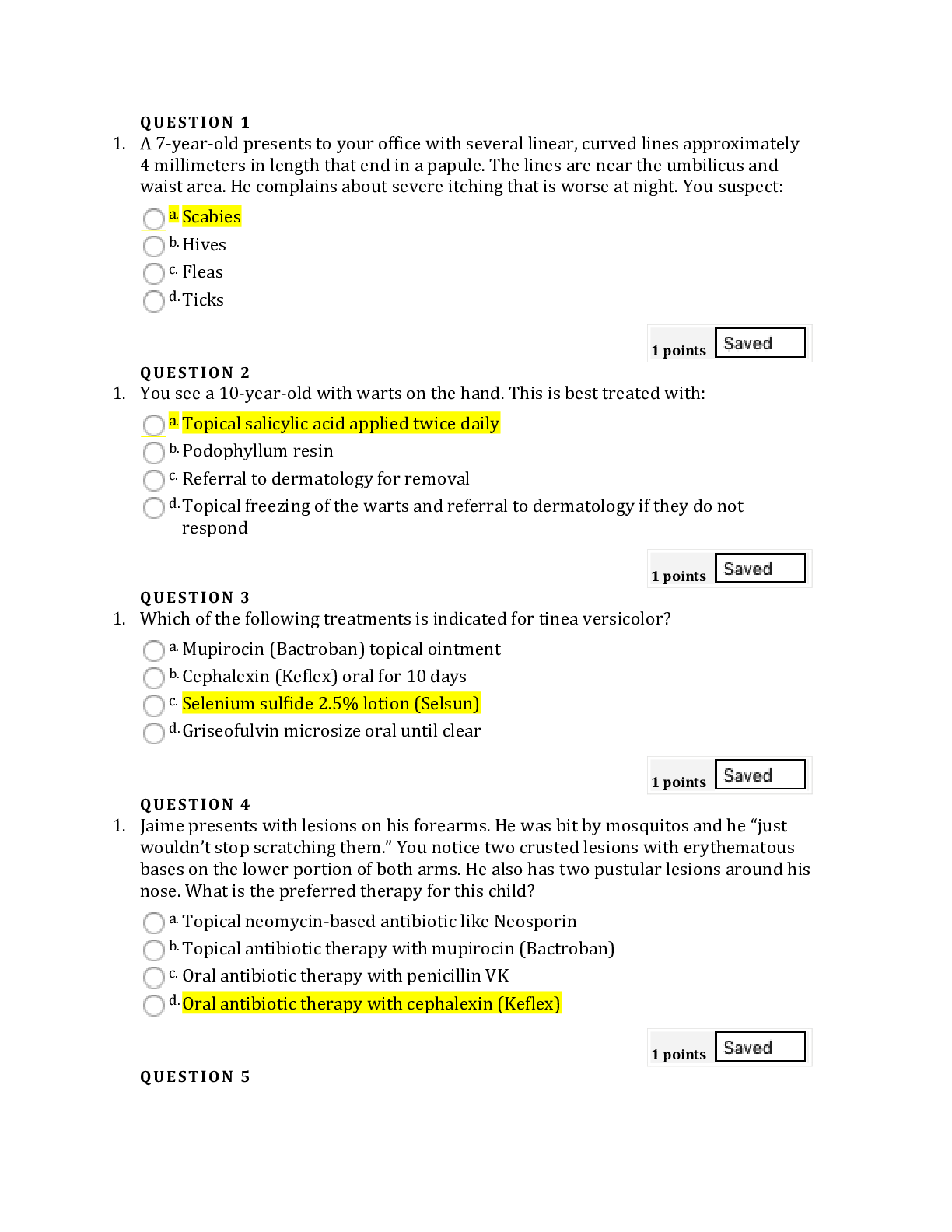
.png)
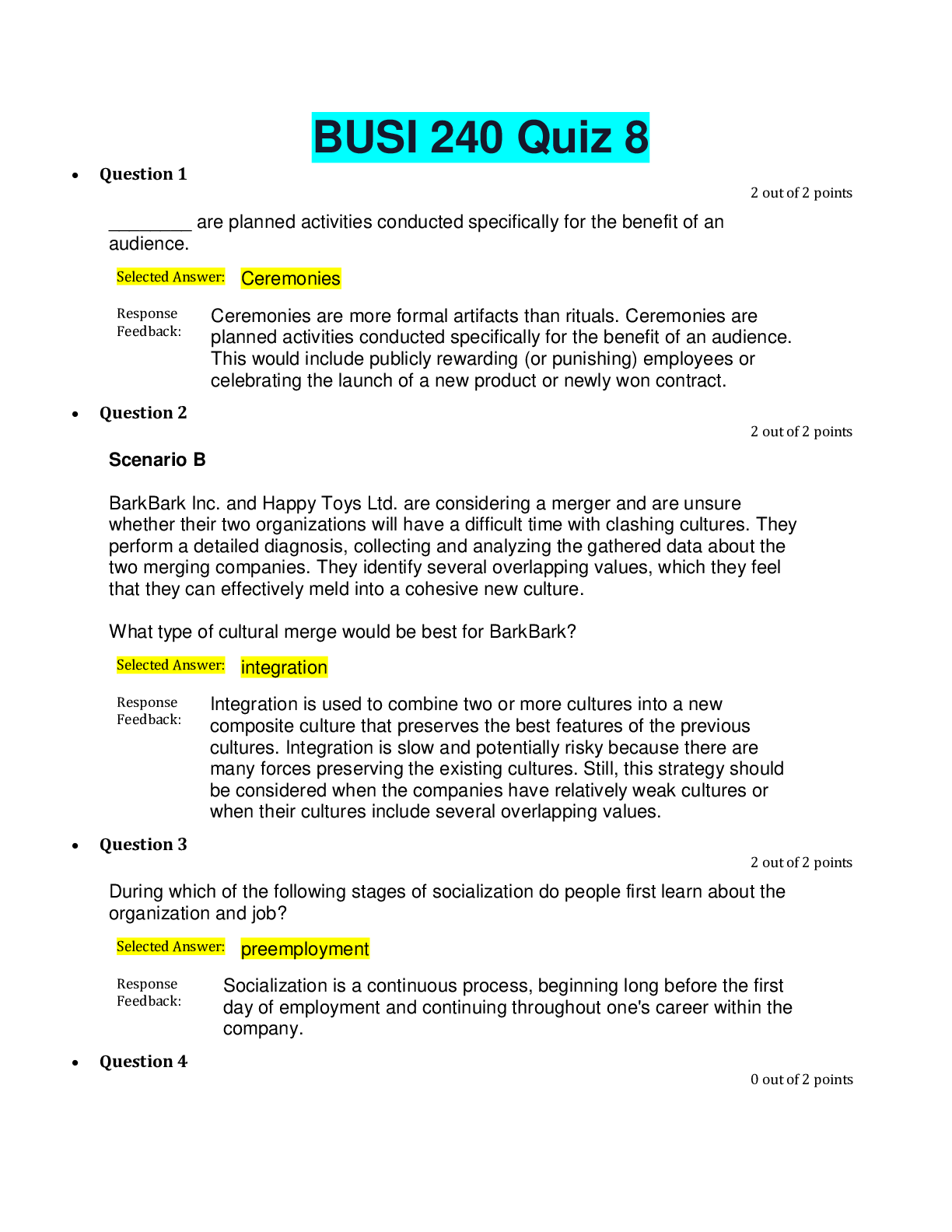
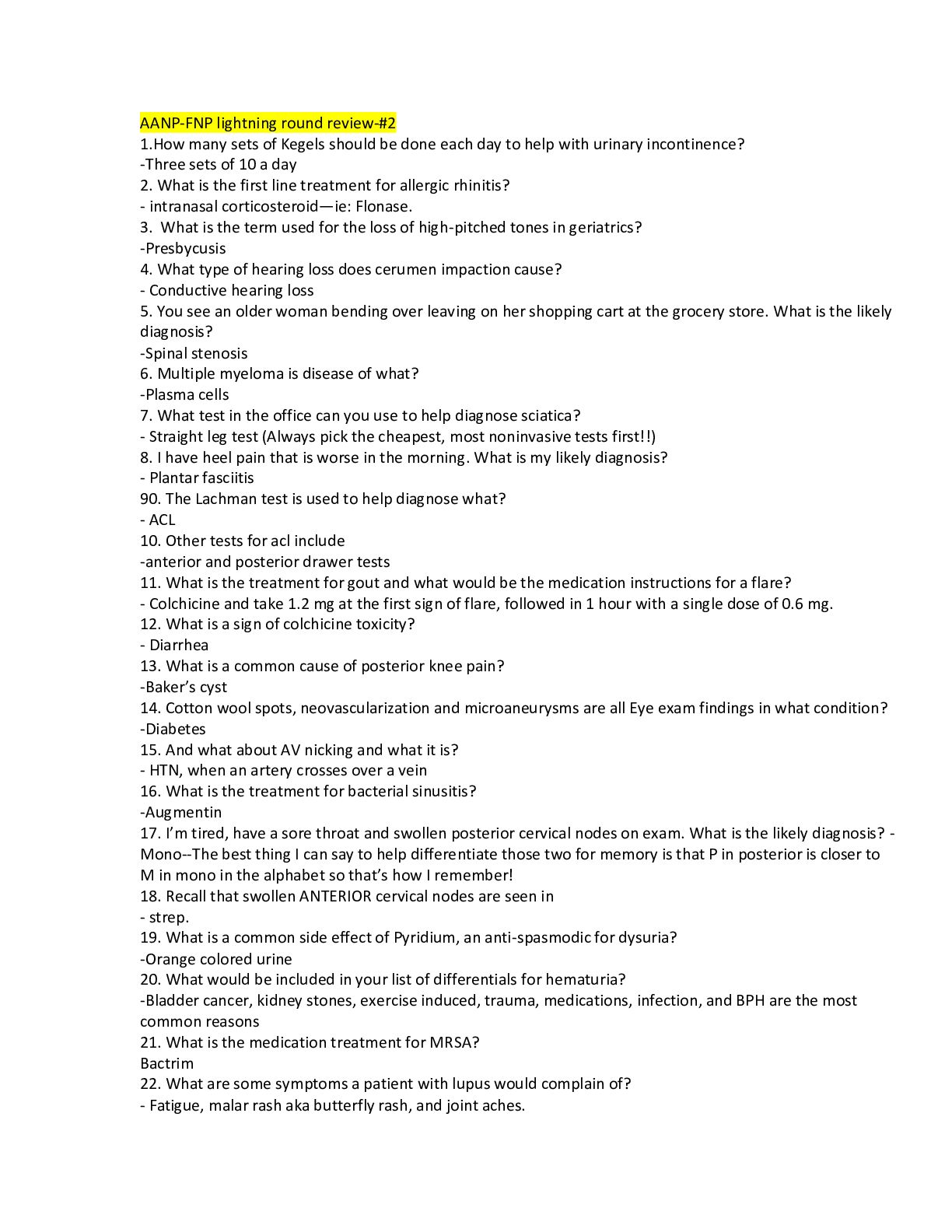
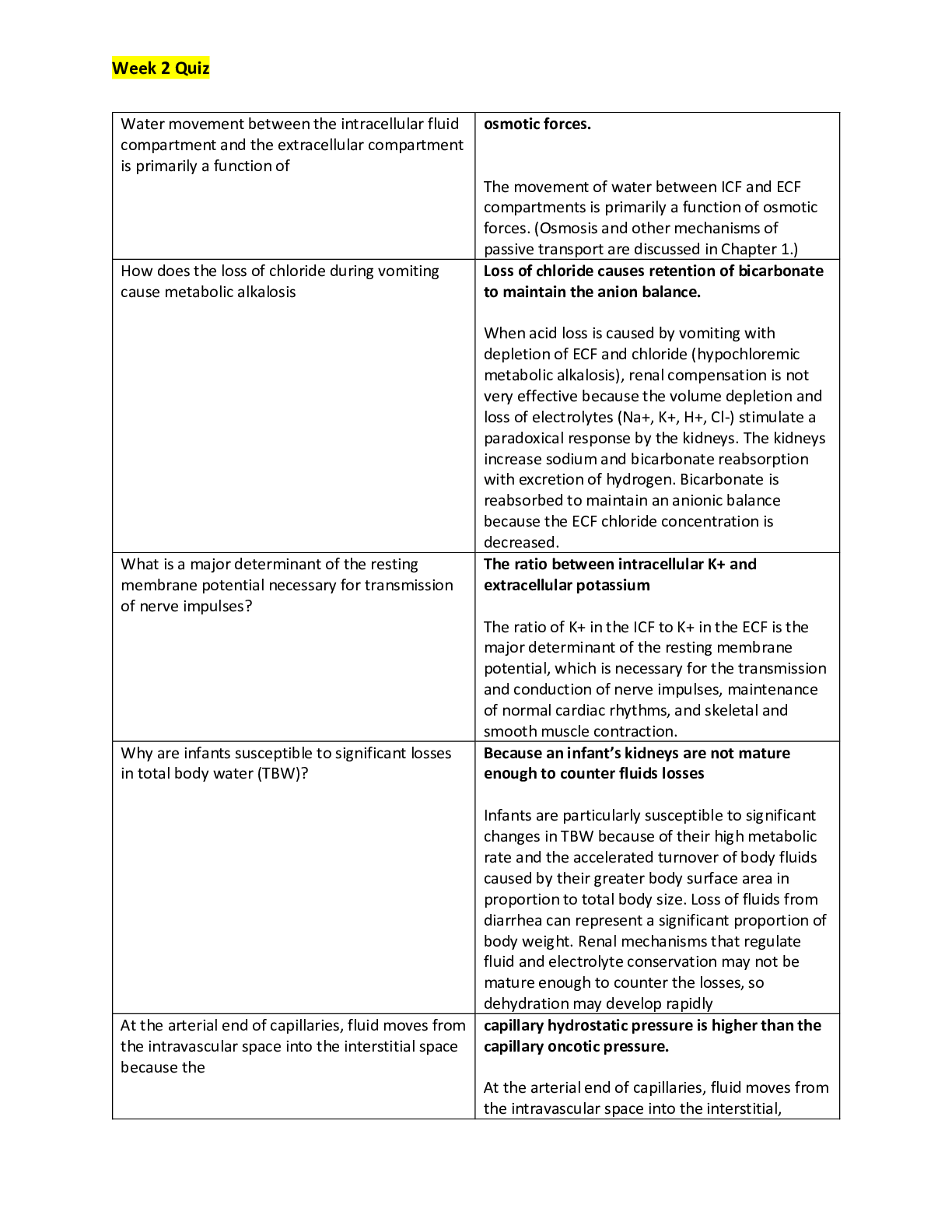
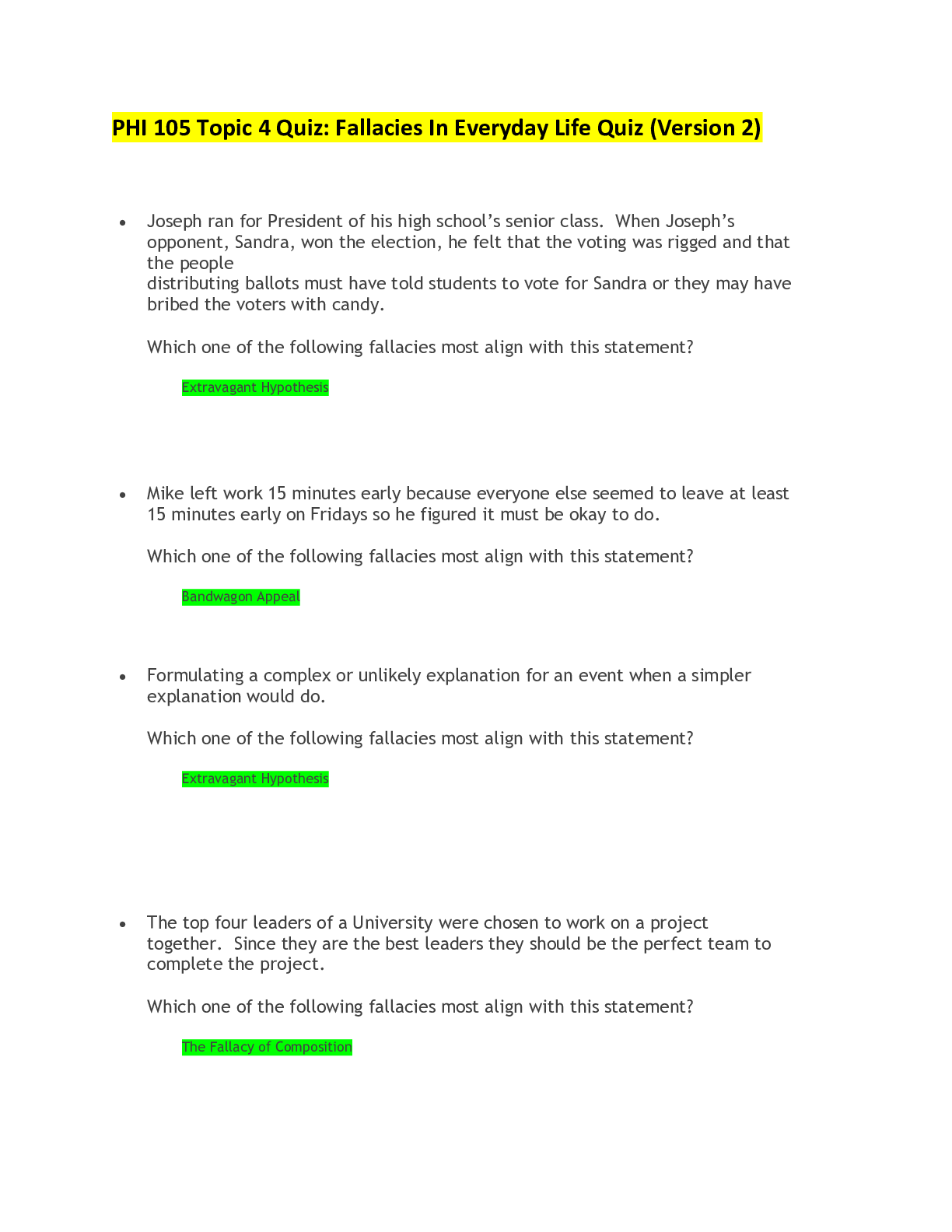
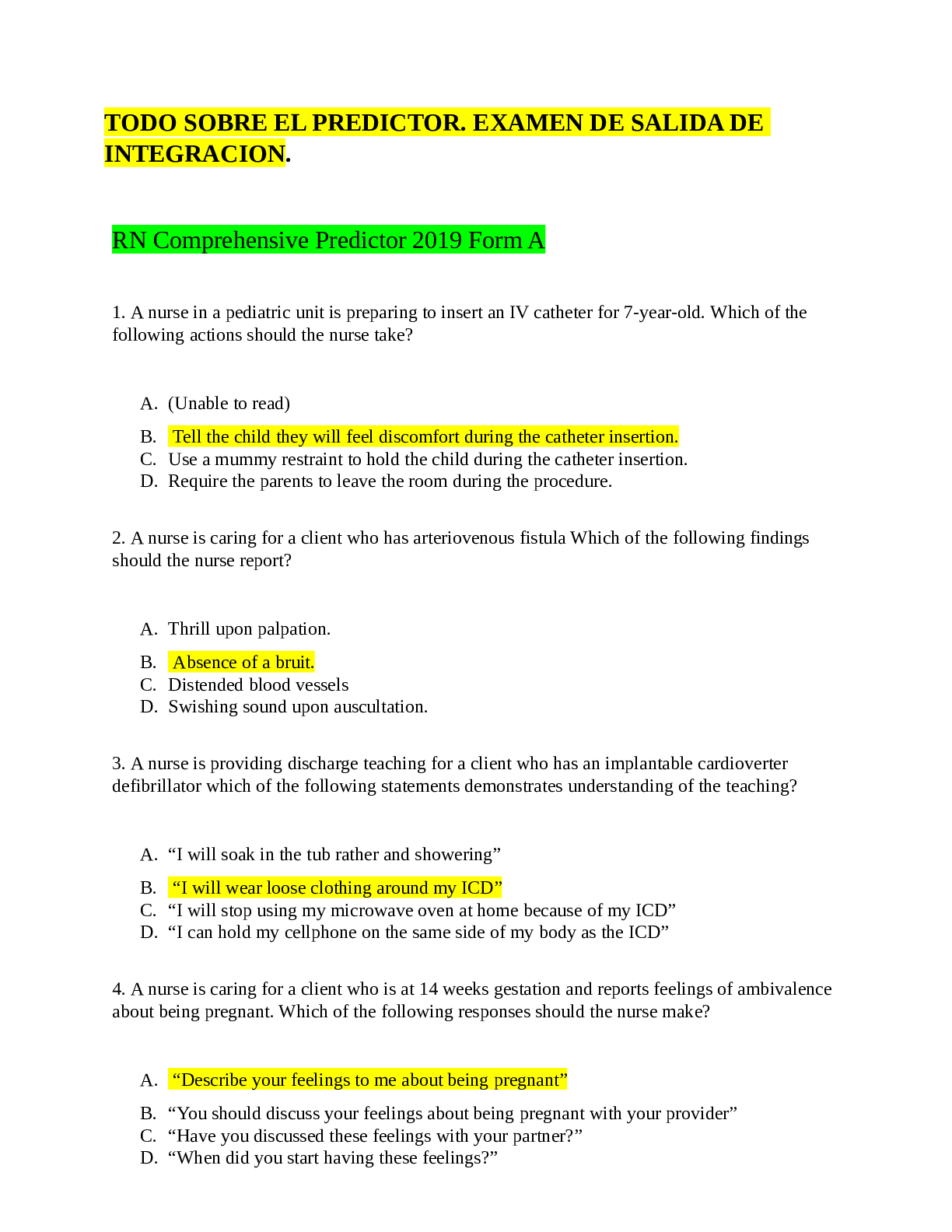
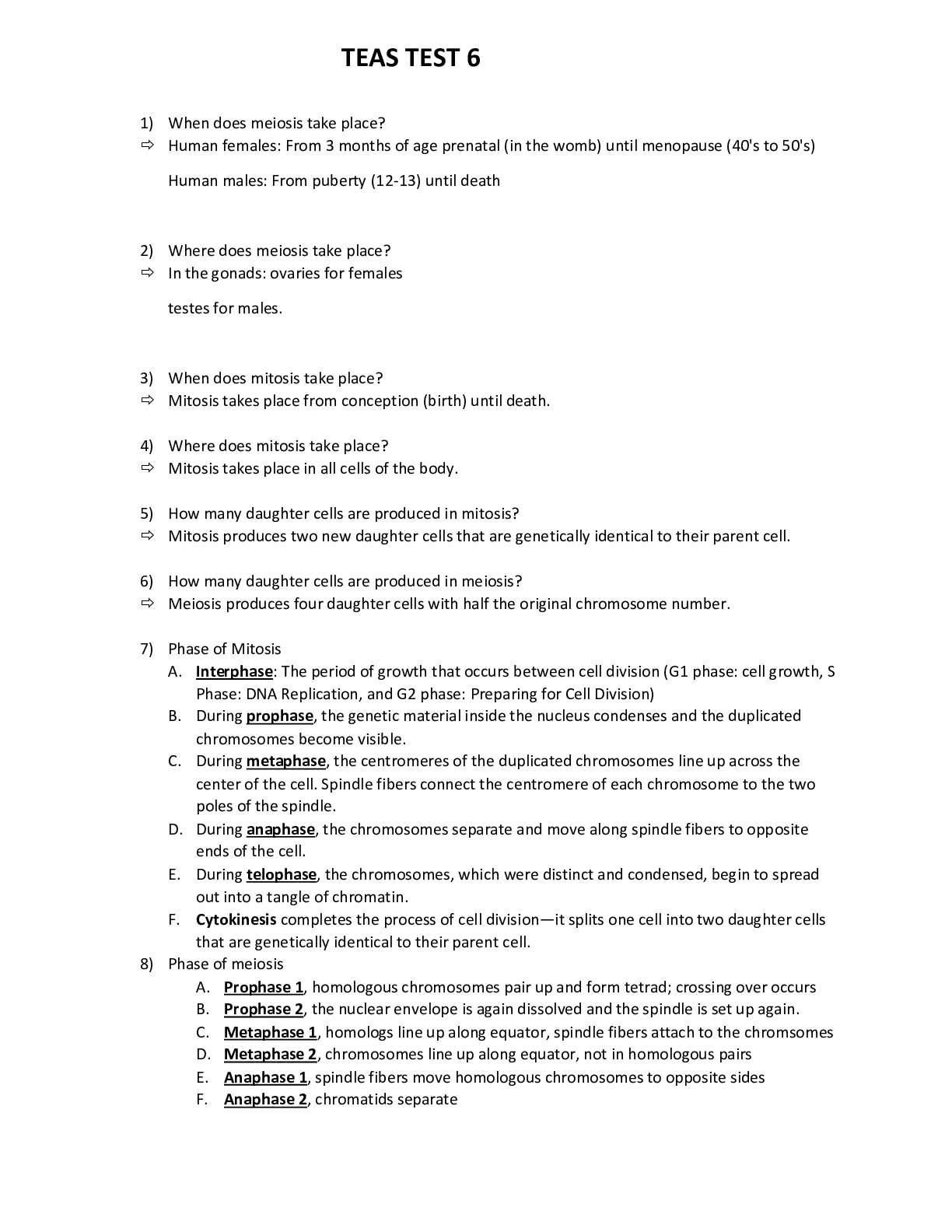
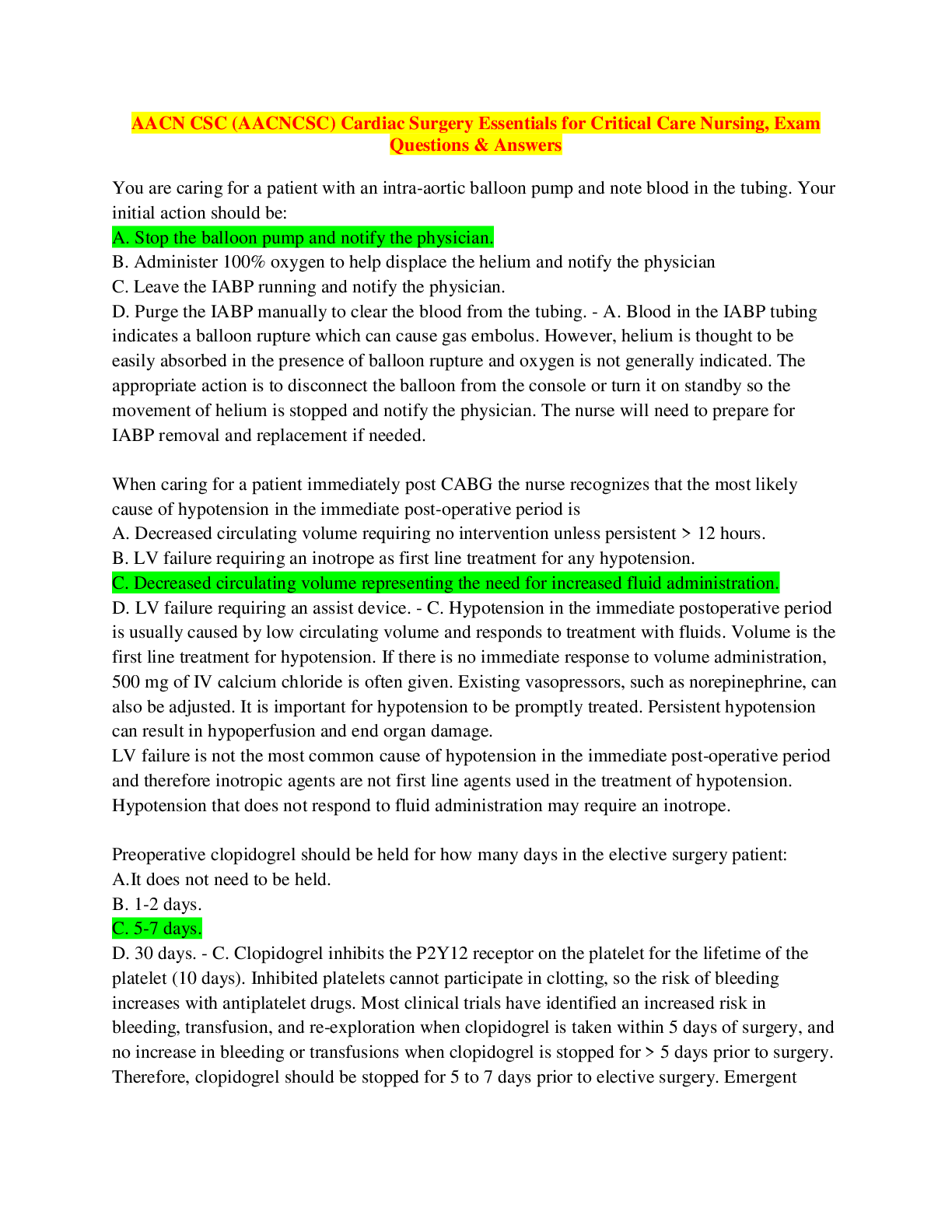
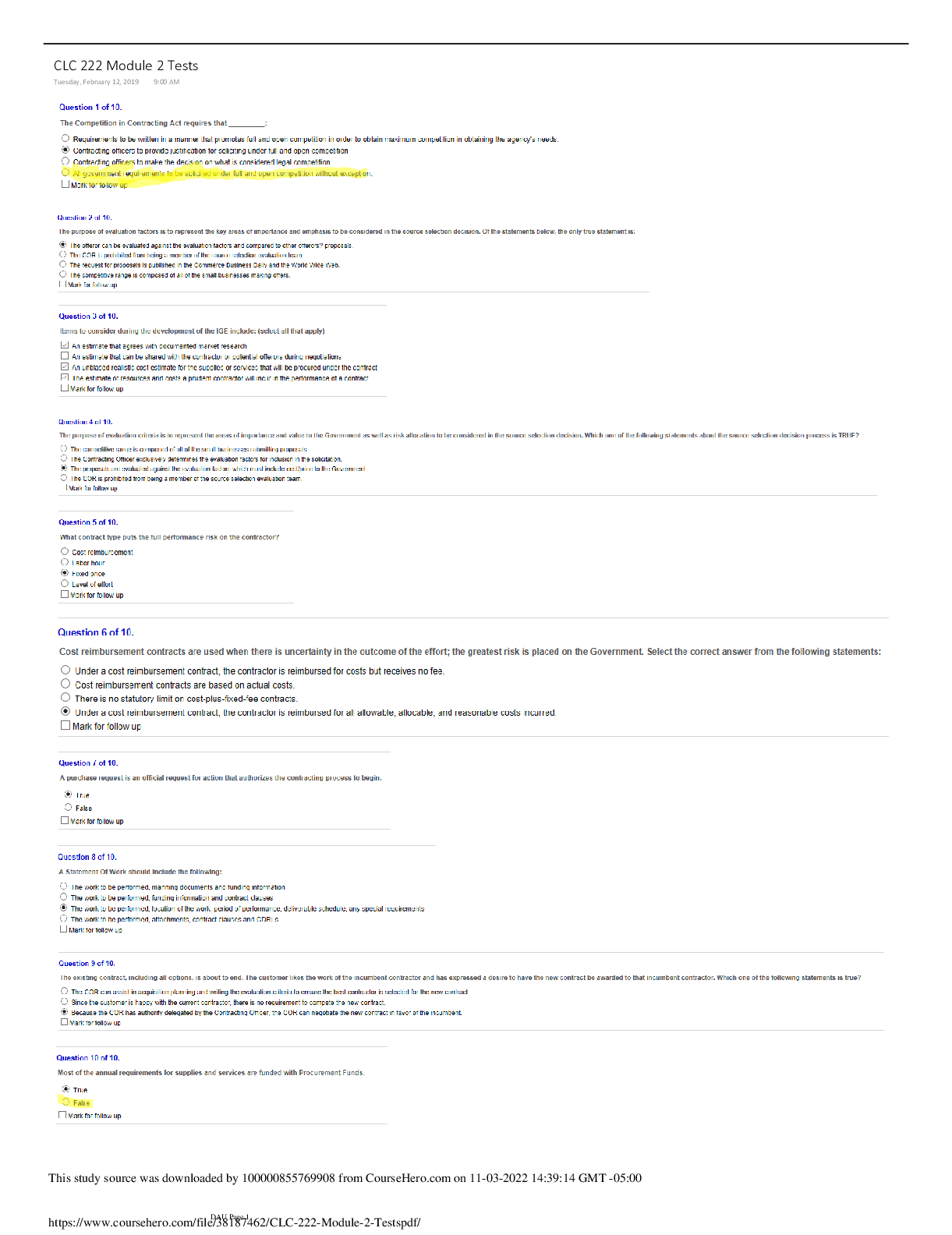
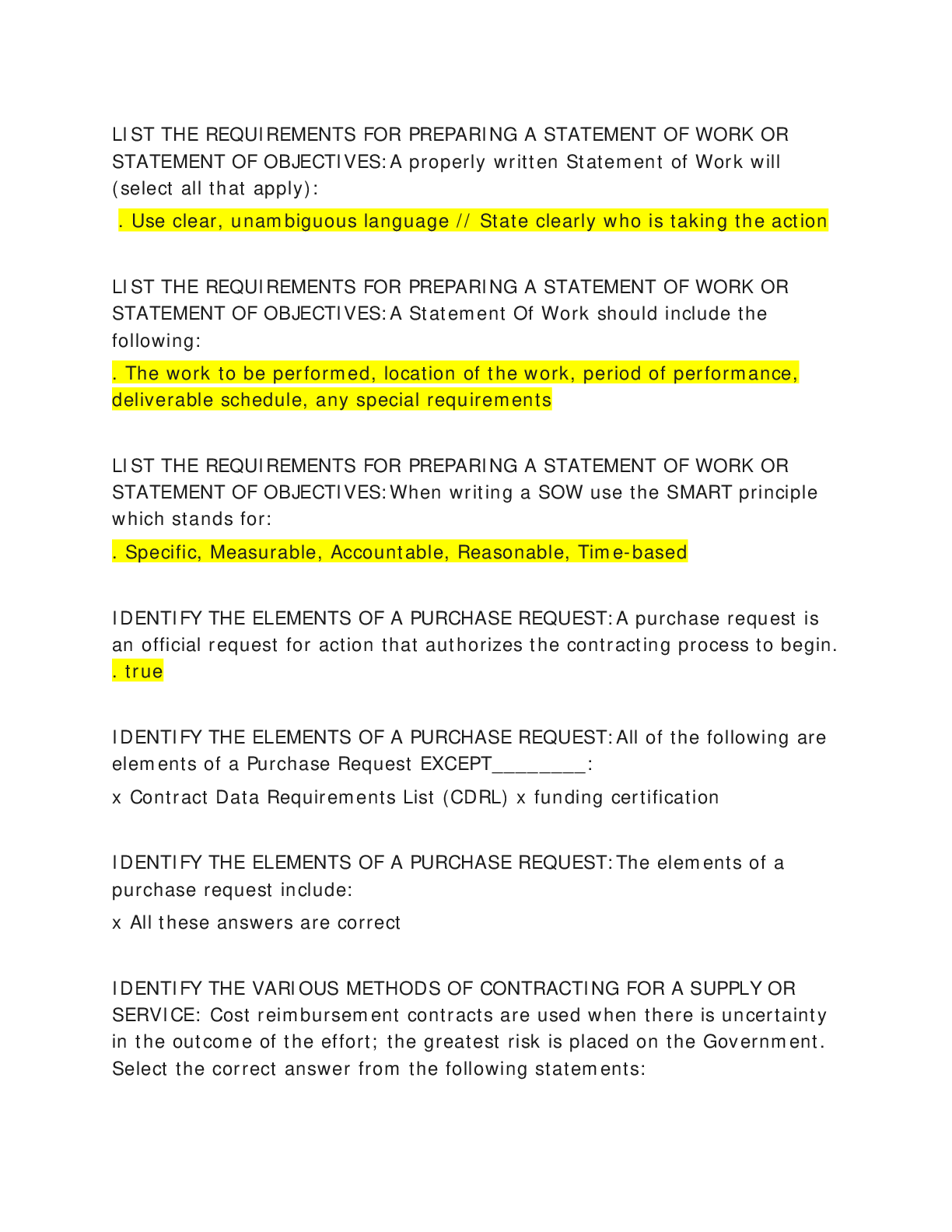
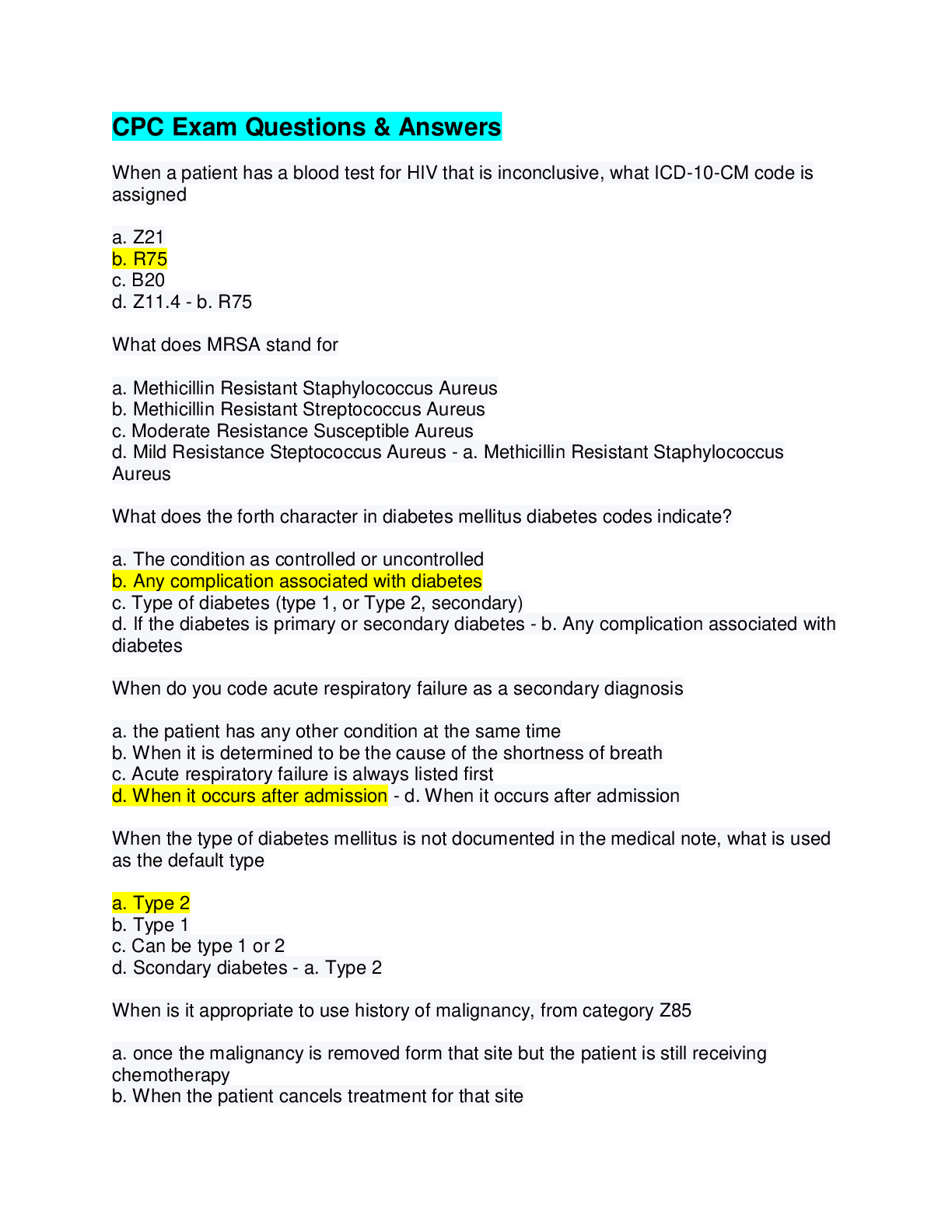
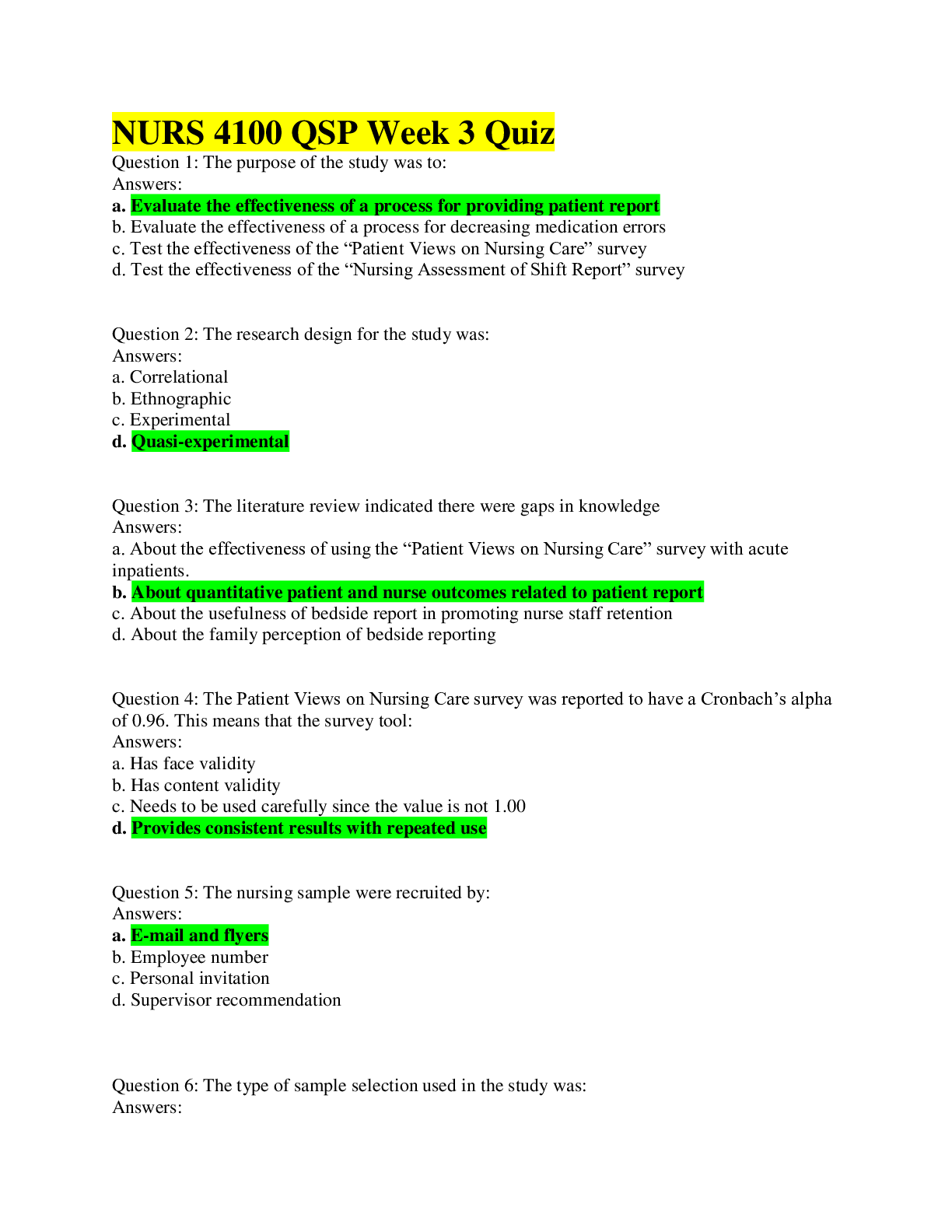
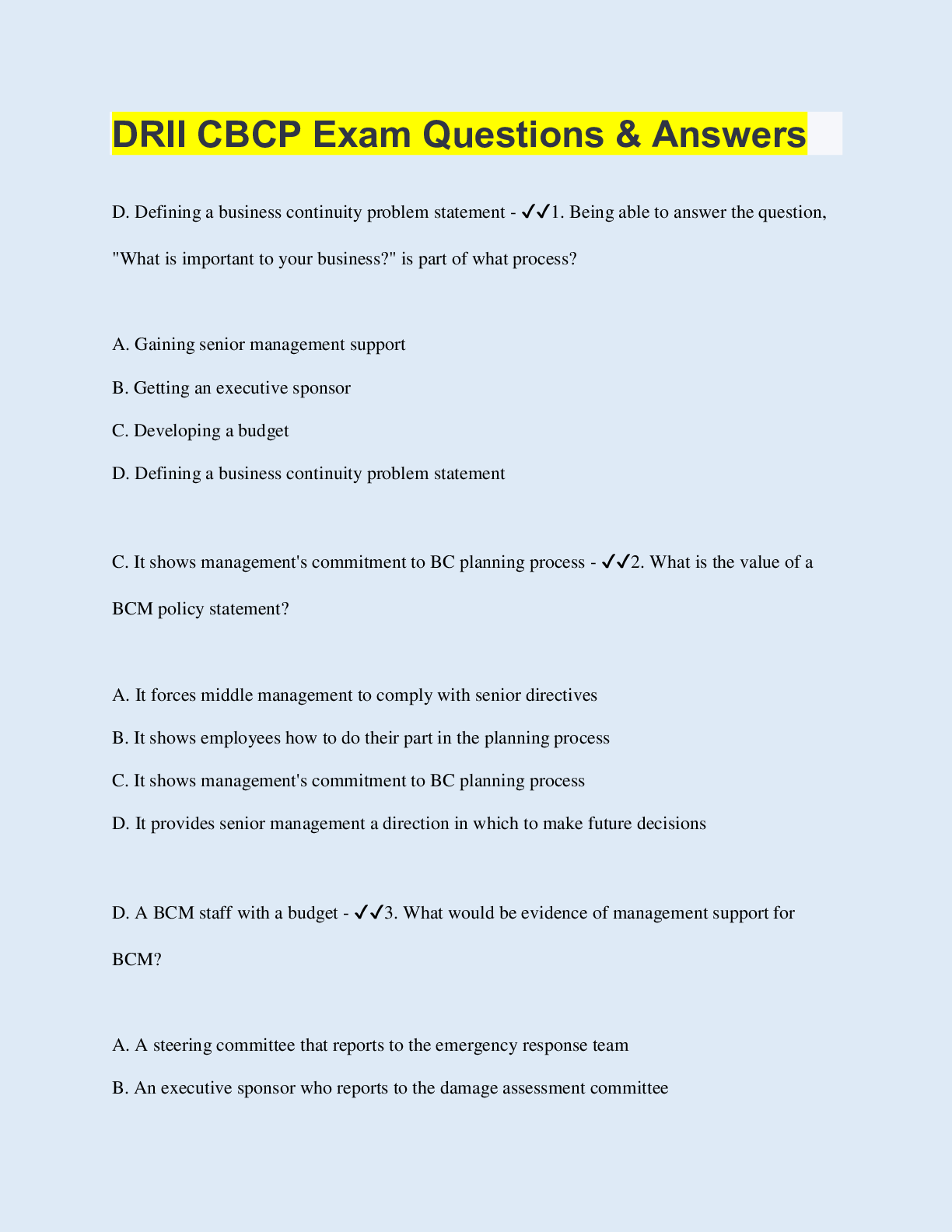
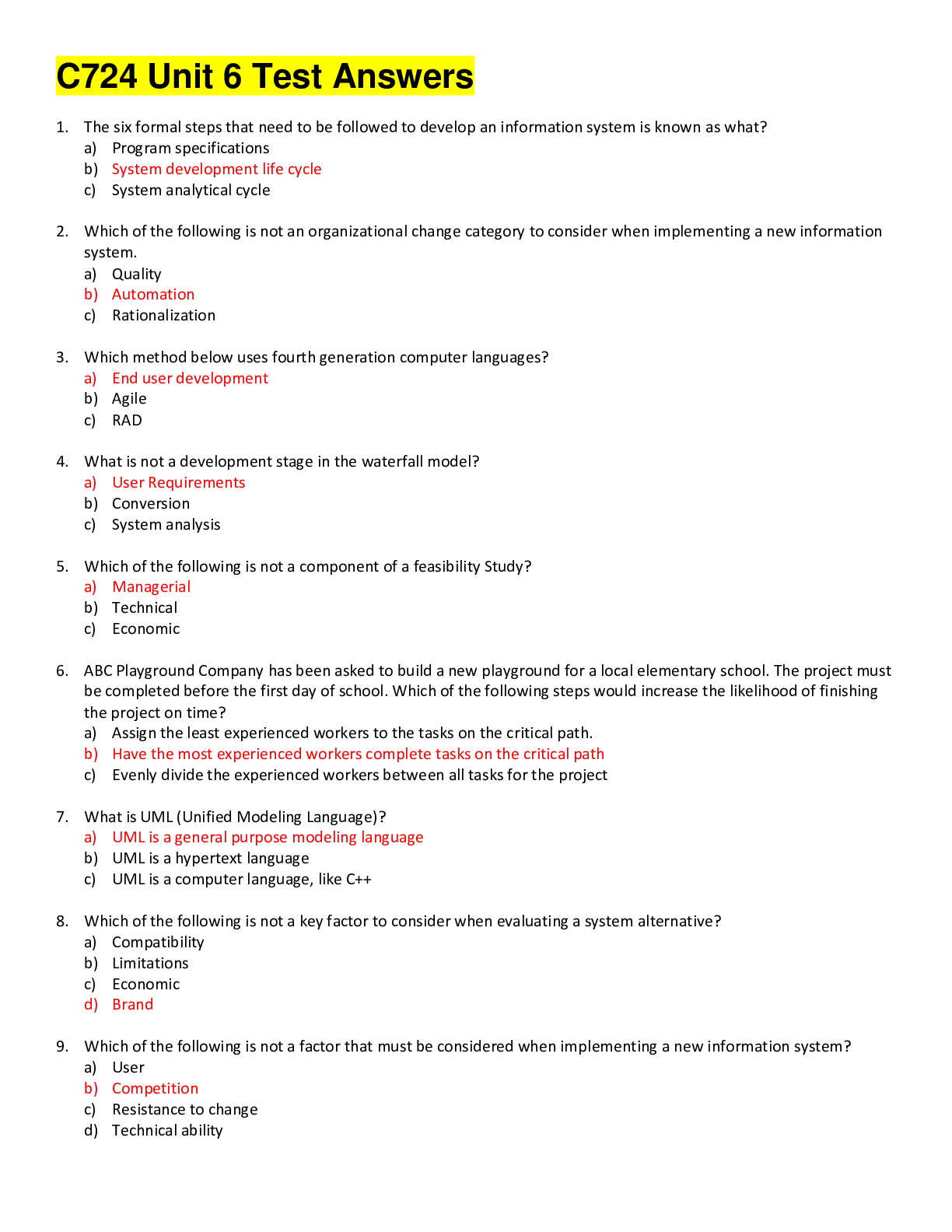
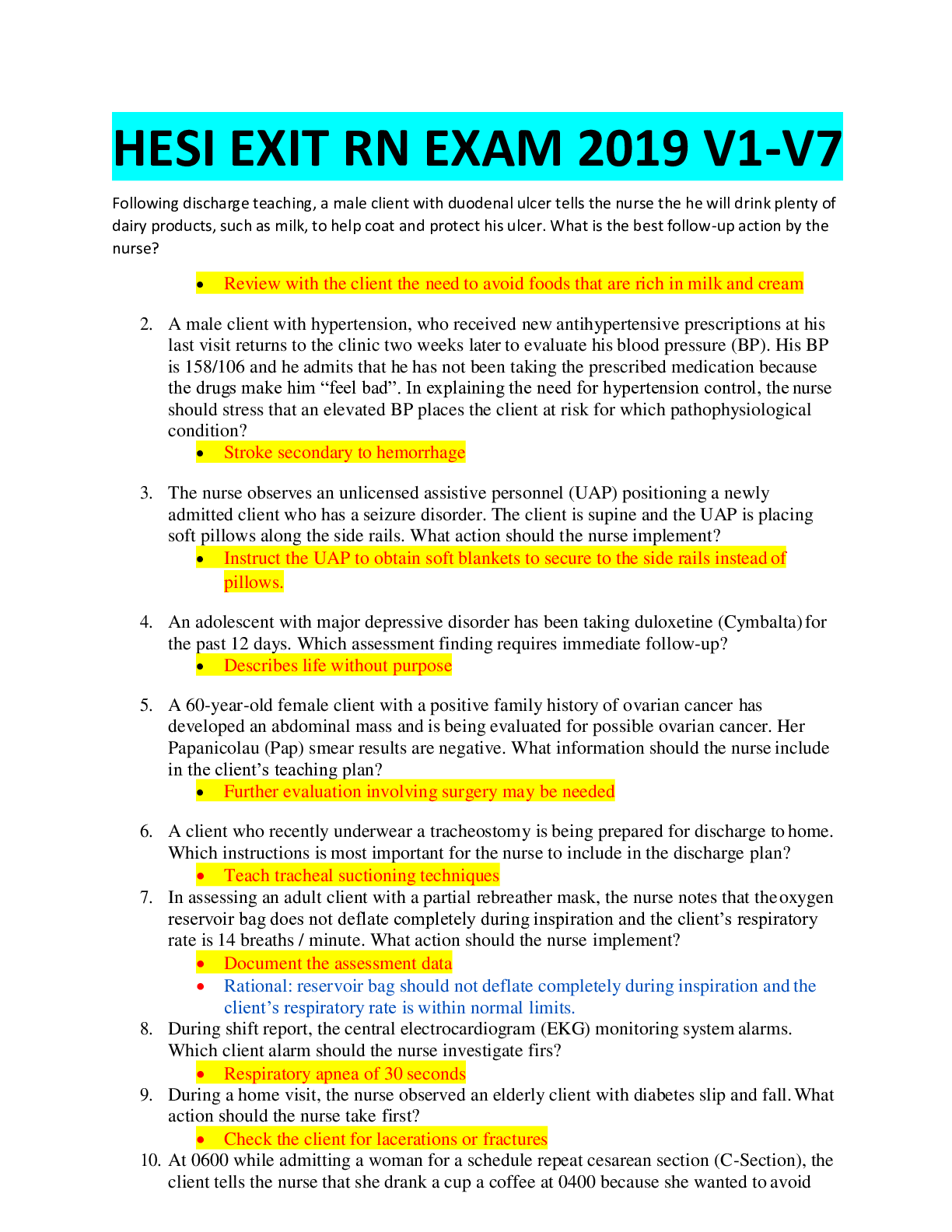
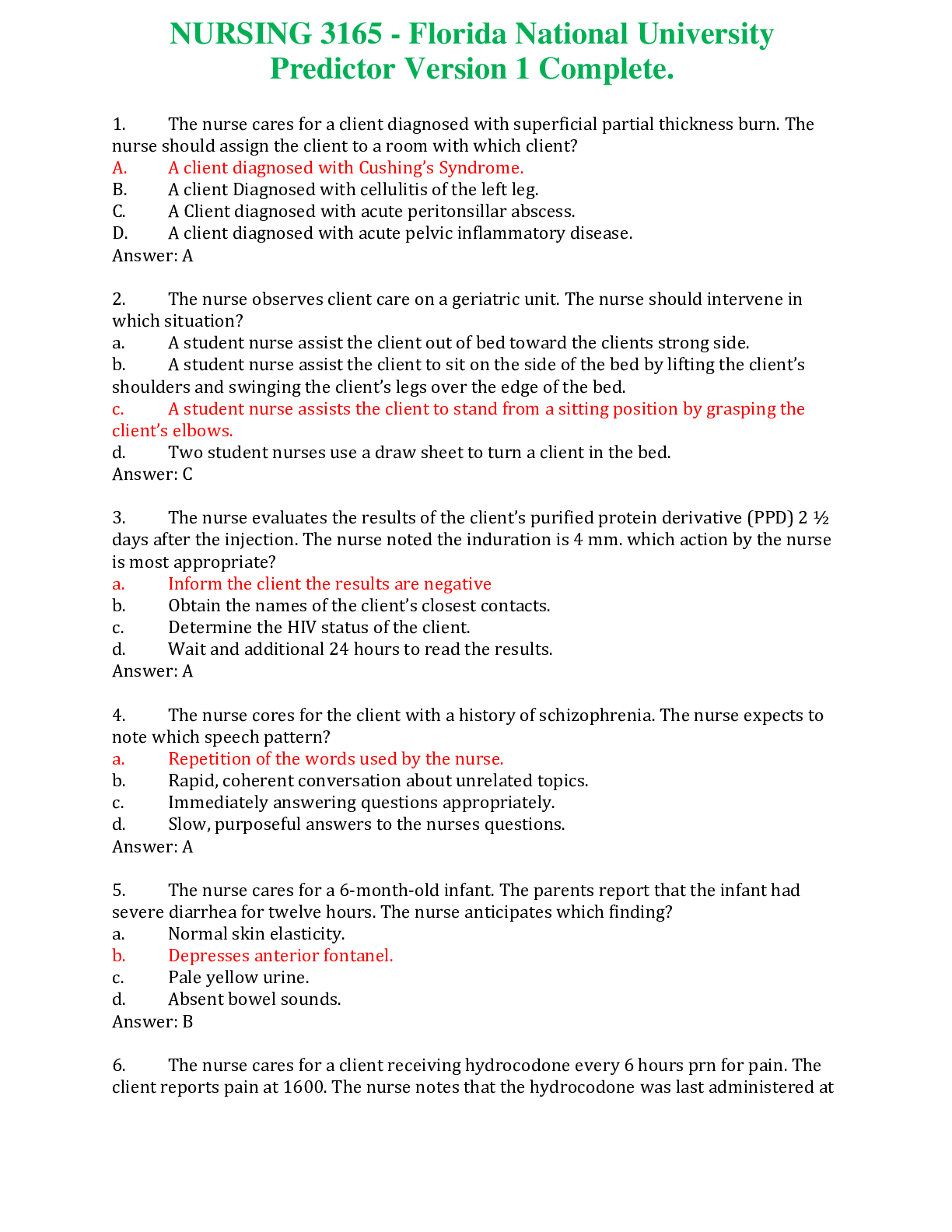
.png)


